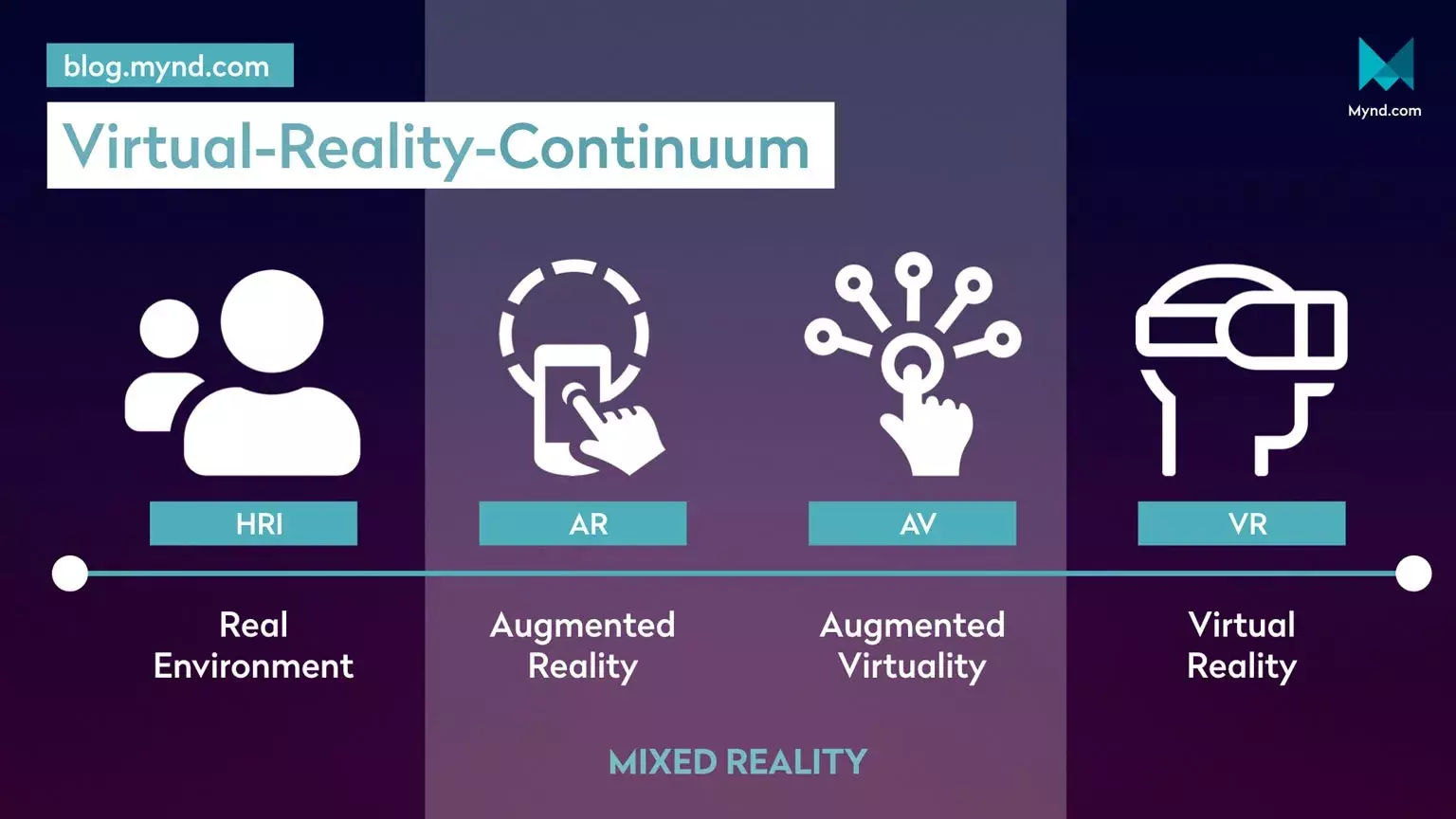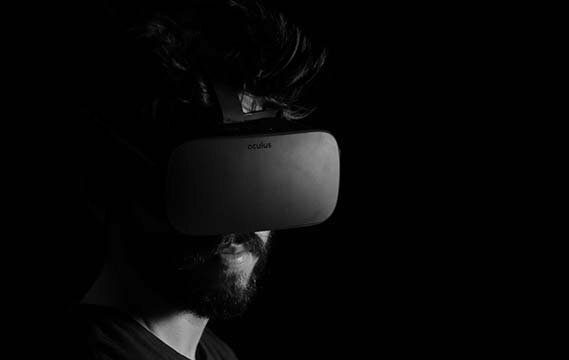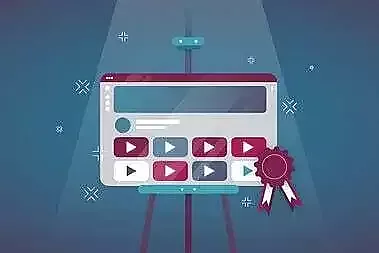Put on your VR goggles and off you go into completely new dimensions. The advance of Virtual Reality has long since begun. It enables completely new virtual experiences with maximum user interaction. Find out which industries are already shaping the future.
No desire to read? Listen to our blogcast here:
In this article you will learn ...
- what is behind the Virtual Reality trend,
- what advantages this technology has for an every company, and,
- which concrete fields of application already determine the future of technology.
Jump directly to exciting VR examples:
Gaming und VR gaming halls,
VR movies and videos,
Concerts and VR events,
Cross-Marketing with Virtual Reality,
VR product films,
360-degree ads in social media,
360-degree ads in social media,
VR in science and education.
Virtual Reality in the Future.
What is Virtual Reality?
Imagine that you are on the train. Instead of watching a Hollywood classic on your laptop, you watch a film on your smartphone using VR glasses. Suddenly, you are surrounded by a completely different world- a jungle following the protagonist in his search for a mysterious treasure. The jungle rustles around you. Something moves in the back bushes. In front of you, the treasure hunter struggles for all your attention.
This scenario is not a dream of the future. It has become reality. The technology behind it is called Virtual Reality and is now so sophisticated that VR high-end solutions are finding their way into American households.
Virtual Reality is a complex technology used to construct computer-created virtual spaces that allow users to dive much deeper into a virtually created world.

In 1994 in the Reality Virtuality Continuum, Paul Milgram described how AR, AV, and VR are separated from each other.
In the same breath, VR is often associated with AR (Augmented Reality). Despite some similarities, the two technologies differ. While VR creates a completely computer-generated world in which a user is isolated from the outside world, Augmented Reality adds virtual elements to the real environment.
In Augmented Virtuality, on the other hand, the completely virtual world is supplemented with real information. These can be real physical objects or people who interact with the virtual space in real time.
Microsoft's HoloLens shows how Mixed Reality can look in our everyday life in the future.
Whether VR, AV, or AR, the niche topic of virtuality has become a cross-industry trend. A huge VR industry has emerged in the USA and billions of US dollars are being invested in promising startups.
Just to name a few statistics:
- It is estimated that in 2021 the global turnover will be about 19 billion US dollars.
- The use of VR has increased by 47% from 2017 to 2018.
- As early as 2018, the global number of users was 14.6 million and is predicted to reach 24.4 million by 2020.
- Worldwide revenues from VR software alone are expected to grow by more than 3000% within 4 years.
High-Tech Experience with VR Glasses.
With the help of Virtual Reality glasses (Head-Mounted-Displays or HMD's) like the Oculus Rift, the Playstation VR, or the HTC Vive, it is possible to achieve a full VR experience.
Using special hardware and software, the user's head and position in the room are measured, and high-resolution images are projected onto two displays at a refresh rate of at least 90 hertz, creating a 360-degree impression.

Purchased by Facebook 2014, the distribution of the Oculus Rift 2016 started with over 300,000 sales after one year
The technology was received by the general public. By 2017, around 9.6 million VR/AR glasses had been sold worldwide. This figure is predicted to be around 69 million by 2022, which is an explosive development!
Experience VR with Your Smartphone.
In addition to the high-end devices for the PC mentioned above, there are also inexpensive headsets that can be used with the smartphone, such as the Google Cardboard. It is made of cardboard in which a smartphone is clamped in, and a three-dimensional virtual reality image is created by various collecting lenses and magnets. The only requirement is an app on the smartphone that supports this spatial-looking view.
Google developed the cardboard, but doesn't produce it itself. Instead, Google provides instructions.
Advantages of VR Technology
The experiences of the users before, during, or after a purchase decision have become immensely important for companies. Due to digitalization and the resulting flood of information, a consumer has to process many advertising messages.
The result of this information overload is an attention span decrease. The demand for good advertising becomes even higher, so whoever draws attention to himself wins. Perhaps. Companies must try to offer the target group immersive experiences, no matter the product. VR is the revolution of digital content consumption!
Virtual Reality, like Augmented Reality, can deliver a unique and entertaining product experience and enable much greater interaction with a brand, ultimately boosting sales and brand loyalty.
VR allows users to do things that would otherwise not be possible in the real world. It offers users an authentic experience with all their senses, so it’s important not to miss this trendsetting movement! We will show you which industries already benefit from Virtual Reality.
VR Fields of Application
Virtual reality in the Entertainment Industry.
Gaming.
VR technology was already on its way to becoming a hype in the 90s. Game developers adapted dozens of games to the new technology. For the time being, however, the technology was only able to convince to a limited extent. Inaccurate tracking and low resolution couldn’t do justice to the hoped-for gaming experience.
Today, things have changed. The Oculus Rift and the HTC Vive achieve a resolution of 1080 x 1200 pixels per eye, and we can expect even more in the future. We are already working on 4K/8K glasses, such as the Pimax 8K, which has been available since February 10, 2019. These VR glasses have an impressive 3840 x 2160 pixels per eye (fly screen effect adé), creating a 200-degree field of view that almost resembles the natural 220-degree field of view of a human eye.
Many VR glasses come with additional controllers to help navigate through the virtual world. The big challenge lies in tracking the sometimes jerky and fast movements of a player and transferring them into the virtual game. The demand of the technology is further increased if the controllers are wireless, ensuring smooth data transmission.
The new VR headset Oculus Quest(formerly Project Santa Cruz) will be completely without cables and external tracking sensors.
Kabelos is also the Oculus Go. These VR glasses make the insertion of the smartphone unnecessary. Data from the WLAN connection is transmitted at the beginning via a smartphone app, so that apps, videos, or photos can be placed on the glasses. The disadvantage of the Oculus Go is that the VR glasses, as well as the associated controllers, track the head and hand movements, but do not measure their position in space. This makes these VR glasses more suitable for use in the event and TV/film industries.
The potential in the gaming sector has long been recognised with VR Arcades. There are VR arcades in which interested parties can fully experience virtual reality under optimal conditions, alone or together. Those who are not playing can still have a good time with snacks, drinks, and conversations.
The German companyHologate distributes virtual, augmented, and mixed reality game stations internationally.
Film and Television.
Three-dimensional films, creating a more extensive cinema experience than with 2D films, are nothing new for today's cinema-goers. Virtual Reality can increase even that!
We are talking about 360-degree films (or VR films). 360-degree videos are films to view all around. The focus here is on independent discovery. There is something for the viewer to see in every viewing direction. That's why 360-degree films often consist of a sequence of a few successive scenes of pure experience and interaction.
This form of video requires completely new strategies for storytelling with stories that people love and will remember. In our XXL Storytelling Guide, you will learn more about the art of telling stories, what forms of storytelling there are, and which companies benefit most from them.
A story can be perceived through VR with several senses, so that artificial worlds, which otherwise remain in the imagination, can really be experienced. At the same time, it requires special skill on the part of the filmmakers to incorporate specific creative and rhetorical elements in the film scenes, which help the viewer navigate through the 360-degree film.
The combination of the strengths of storytelling and virtual reality brings completely new dimensions to content development, user experience, and ultimately corporate success. Professional video companies specialize in the creation of such videos.
This example shows how the viewer can be guided through the 360-degree VR video by correctly applied storytelling:
With your mouse you can change the viewing direction- an experience even without VR glasses.
Disney shows how complete VR film worlds can look. With the specially created Disney Movies VR, the media giant creates a complete virtual world around VR films by Disney, Marvel, and Lucasfilm:
Users navigate interactively to the VR movie in the Disney Movies VR App. VR-Youtuber Wanderlvst shows what the usage looks like.
Due to the high interaction rate and the technical effort involved in production, VR films are usually shorter than classic films and, currently, rarely last longer than 10 minutes.
This may also be one of the reasons why VR is not compatible with classic television. Here we have traditional 2D flat screen entertainment paired with often several hours of passive TV watching, which tends to be a common activity.
Apps like Oculus TV, Hulu VR, or Netflix VR create a virtual living room in which the TV screen is placed in front of a sofa where the user sits and watches the streaming services’ series and movies using VR. The series experience is complemented by the virtual environment, not the film itself.
Hulu is a video portal for video on demand and competitor to Netflix.
Concerts, Functions, and Events
Attending a concert of your favorite band is a special experience. However, tickets are limited and not everyone can attend an event for financial, local, or personal reasons. The potential to make a live event available to multiple people is huge.
The reach of such mega-events can be increased by Virtual Reality. Concerts can be experienced in a way that has never been seen before- from anywhere by anyone. VR concerts bring completely new perspectives. For example, you can view the stage from the front row or from flying above.
This happened in July 2017 when Universal Music made the Queen concert with Adam Lambert in Barcelona available as a 360-degree VR experience:
Change your perspective with the mouse and see the Queen concert in 360 degrees- even more impressive with VR glasses.
In the future, concerts can be experienced live through VR. Instead of being in a big stadium, you can watch the concert from many different places through Virtual Reality, which opens up completely new opportunities and dimensions for artists and spectators.
Samsung broadcasted a VR concert of the British band Years & Years live on the Internet for the first time in 2016. Viewers from all over Europe were able to follow the concert with Samsung Gear VR glasses via interactive livestream:
Recording from the VR concert- effects and staging created additional atmosphere making a special experience with VR glasses.
What if users don't just want to experience the event in VR, but want to become part of it, even if they can't be physically there? Facebook with Oculus Venues turns this thought into reality. Using an avatar, the user can be virtually present at an event with others and talk about it.
A live event selected in the calendar and catapulted directly into the action by VR, together with other VR viewers.
Other events, such as conferences and trade fairs, could also open up completely new dimensions this way in the future for participants and companies. This is only the beginning of where Virtual Reality can go in the future. Every company can profit from the mega-trend of Virtual Reality.
Virtual Reality for Marketing and Sales
Cross-Marketing Measures.
The interactions and possible collaborations that can arise between different industries as a result of virtual reality is very interesting.
In the USA, for example, a VR attraction to the film How to Train Your Dragon: The Hidden World has been launched. Dreamworks and Walmart are trying to boost sales of merchandise with VR glasses and movable VR special armchairs. After a dragon ride together with the main characters through the fantasy world of the film, users are taken to a fan shop.
Both companies benefit from this VR advertising campaign. The American supermarket chain is able to advertise the film while, at the same time, benefitting from the popularity of the film, attracting more customers and selling more products.
The VR attraction alternates between 16 American Walmart stores in the USA.
VR Product Films in 360 Degrees.
We already discussed in a previous article the use of product videos in online shopping increases sales. Now imagine how much the viewer's shopping experience can increase if they have a 360-degree VR experience with your product. The customer can better imagine and even interact with the product through virtual reality.
What exactly can this look like? IKEA is leading the way with the Virtual Reality Showroom:
Whether size, color, or rating, IKEA creates completely new local shopping experiences for its customers.
IKEA also sets clear standards when it comes to mobile shopping. With Augmented Reality, the furnishing company brings its furniture virtually to the customer's home, without having to go to a store beforehand. With the IKEA Place App, users can take a look at the furniture and see what it looks like in their own home:
IKEA Place eliminates the need to measure and helps customers better imagine potential furniture in their own homes.
360-Degree Ads on Social Media.
Up to 8 billion video contents are consumed daily on Facebook. 360-degree videos can attract more attention in this content competition, standing out from the crowd and remaining memorable to the user.
The 360-degree video function has been available on Facebook and YouTube since 2015, enabling companies to reach their audience in a completely new way. Viewers can discover all-round views of products or locations. With a 360-degree advertising spot, you increase activation and interaction of your users with smartphone social media use.
The native integration on Facebook, as well as YouTube and Snapchat, allows companies to easily upload and promote their VR videos.
Here you'll find instructions on how to promote your 360-degree video on any platform:
- Directly upload and promote 360-degree videos on Facebook.
- Upload 360-degree videos to YouTube and advertise as TrueView ads in AdWords.
For the release of the second part of Fifty Shades of Grey, Universal Pictures used a 360-degree ad on Snapchat to provide its fans with an exclusive insight into the masked ball, one of the film's key scenes. It was a huge success. Universal achieved double the commitment and 50% more time a user spent with the ad.
Just in time for the cinema release, fans of Fifty Shades of Grey were able to immerse themselves in a scene from the film.
Virtual Reality in Tourism.
Virtual journeys bring users with VR glasses to even the remotest places in the world, without physically changing location. Whether kitesurfing over the Grand Canyon, diving with whales off the coast of New Zealand, or climbing Mount Everest, Virtual Reality makes it possible to get close to and experience.
In a 360-degree video, AIDA gives an insight into what it looks like on board.
VR games and VR videos on active trips bring exciting impressions into what a viewer could really experience. The virtual reality game Everest VR lets users climb Mount Everest. Google is also responding to the trend with Google Earth VR, making it possible to experience around 197 million square miles in flying time.
As if you were flying once around the world with Google Earth VR.
Virtual Reality in Medicine, Science, and Education.
April 14, 2016 – one of the greatest milestones in the history of medicine. The British physician Dr. Shafi Ahmed transferred the first operation via Virtual Reality into a worldwide available live stream. Using VR glasses, users were able to follow the removal of the tumor, live, in the 360-degree operating room.
Such technical recordings offer endless possibilities in the implementation, prevention, and further development of medical interventions and for the further training of students all over the world. They receive practical experience while not endangering patients.
Virtual Reality can also help to treat phobias, paranoia, addictions, and fears in patients or contribute to pain relief in so-called phantom pain. Doctors themselves can use the technology to inform their patients in advance with virtual images or to give them a precise idea of a procedure.
Surgical Theater helps neurosurgeons get a three-dimensional idea of their case through VR.
In the future, VR could also gain importance in school education. Students already can learn interactively by digital instruction with Virtual Reality:
With VR-Eduthon, Cornelsen and Samsung bring virtual reality to schools.
Outlook.
Our examples and fields of application show only a fraction of what Virtual Reality can be used for and what makes it possible. We are still at the beginning of a mega-trend that will shape the future. What is not yet a basic technical requirement in households today will help influence our everyday lives in the coming years.
The numerous possibilities of VR technology to create completely new interaction paths between virtual users and to enable new connections between different technologies, media, and industries are particularly exciting.
Companies that want to use VR should seek professional support because:
- VR videos cannot be created with normal video technology. Special cameras are needed that are specially designed to film from various angles.
- 3D technology is very different from 2D as well as the knowledge about it.
- It needs certain hardware and software, such as apps.
VR is not quite where it needs to be for endless uses to help companies. However, the potential of VR is so great that companies should be prepared for this trend. We would be happy to support you on your journey into the virtual future with video »



